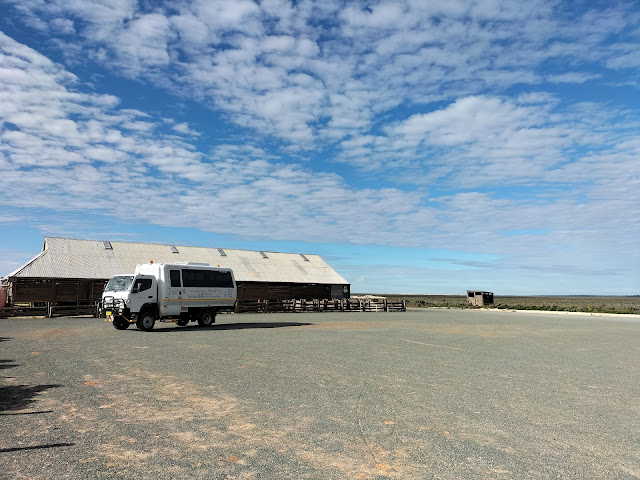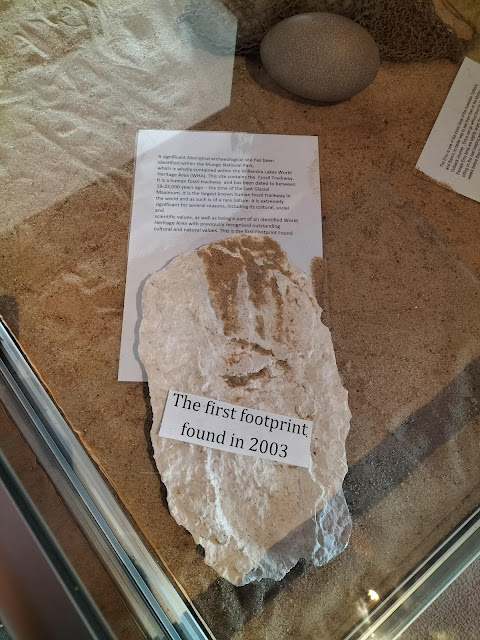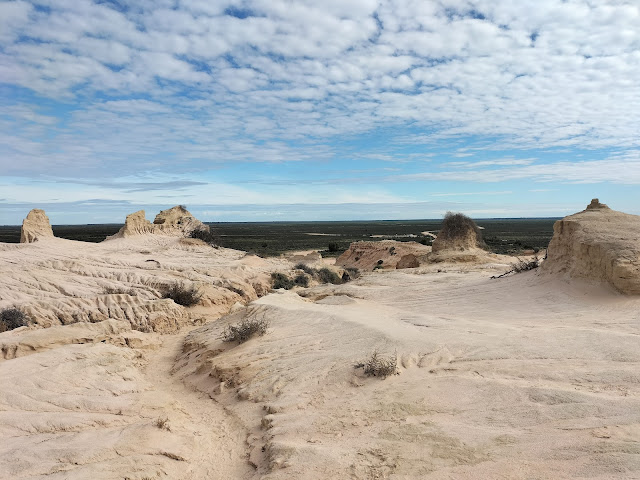Mungo National Park (NSW, Australia)
After a long break from travelling due to the ongoing COVID-19 pandemic and being in the process of completing my PhD, I had the chance in June to take a week off work and travel to a part of Australia I had never been to before. While driving from Adelaide to Melbourne, I visited Mungo National Park in the World Heritage listed Willandra Lakes region in western New South Wales.
Inside the Visitor Centre is a small museum with information about the history of this region, dating from prehistoric times when megafauna roamed this area, all the way through to the relatively recent archaeological discoveries at Mungo.
Outside the visitor centre is a monument to the antiquity of Lake Mungo, with imprints of footprints to represent the ancient footprints found here. There is also a carved stone showing the lakes and footprints of the region.
The area outside the visitor centre also has a platform, with a view of the Woolshed and surrounding area with vegetation.
In this part of the tour you get to follow the guide for a walk among the Walls of China geological sand formations that are iconic of Mungo National Park. Walking through the formations is a surreal experience, feeling a bit like a moonscape or another planet.
Visiting Mungo National Park was an amazing experience, particularly for an archaeologist and amateur geologist like me. It's incredibly exciting to see the antiquity of this country and the ongoing cultural legacy dating from tens of thousands of years ago.
Mungo National Park is known for its amazing geological formations, having been one of the lakes in the Willandra area in the Pleistocene epoch (ending 11 700 years ago). The lakes dried in the Late Pleistocene, about 18 500 years ago, and Lake Mungo is famous for being one of the oldest places outside of Africa with evidence for Homo sapiens.
The roads in Mungo National Park are unsealed and it had been raining a lot recently, so I took a guided day tour with pick up at Mildura Visitor Centre. The drive into the park took about an hour and a half from Mildura. The tour first drops you off at the Mungo Lodge for a light morning tea.
The first stop after the Mungo Lodge was the Mungo Visitor Centre, located next to the Woolshed and Homestead from when this area was used for farming.
Inside the Visitor Centre is a small museum with information about the history of this region, dating from prehistoric times when megafauna roamed this area, all the way through to the relatively recent archaeological discoveries at Mungo.
The exhibits also provide information about the local Indigenous people in the Willandra Lakes region, the Ngyiampaa, Mutthi Mutthi and Southern Paakantyi people. Part of the significance of Mungo National Park was the discovery of two cremated burials here. They are known as Mungo Man and Mungo Lady, dating from 40 000 years before present. The burials were found with ochre, and are thought to be the oldest ritual burials of Homo sapiens found so far. Other archaeological remains included footprints, a cast of which is seen below from the Mungo Visitor Centre museum.
Outside the visitor centre is a monument to the antiquity of Lake Mungo, with imprints of footprints to represent the ancient footprints found here. There is also a carved stone showing the lakes and footprints of the region.
The area outside the visitor centre also has a platform, with a view of the Woolshed and surrounding area with vegetation.
After spending some time around the visitor centre, the next part of the tour takes you towards the edge of Lake Mungo. The great part of taking a guided tour is that you can visit parts of the national park that tourists cannot go to on their own.
In this part of the tour you get to follow the guide for a walk among the Walls of China geological sand formations that are iconic of Mungo National Park. Walking through the formations is a surreal experience, feeling a bit like a moonscape or another planet.
After exploring the amazing geology of this area, the tour heads back to the Mungo Lodge for an included lunch that we put in the orders for when we had our morning tea. Next to the pathway that leads you to this tour-only access area is a stone monument to one of the guides who worked at Mungo for a long time, Leslie James (Whyman) Taylor.
The drive back through Lake Mungo takes you past the sights already explored, and shows the huge size of the expanse of the flat lake bed with vegetation stretching into the horizon.
After a delicious calamari salad lunch at Mungo Lodge, the tour bus took us back to Mildura.
Visiting Mungo National Park was an amazing experience, particularly for an archaeologist and amateur geologist like me. It's incredibly exciting to see the antiquity of this country and the ongoing cultural legacy dating from tens of thousands of years ago.
Information about visiting Mungo National Park is available on the NSW National Parks and Wildlife Service website and you can find a detailed map of Mungo National Park here.

















Comments
Post a Comment